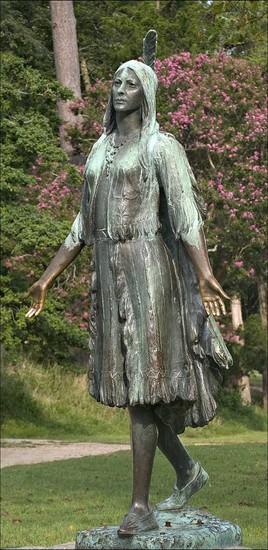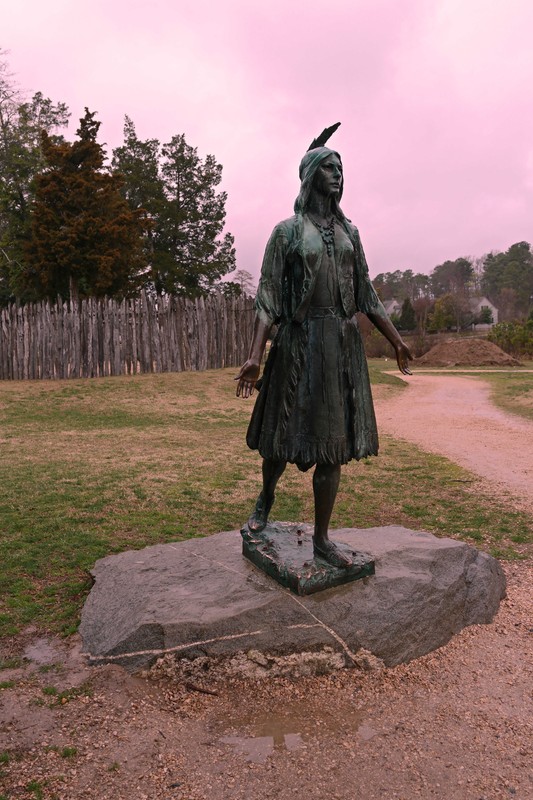Pocahontas Statue in Historic Jamestowne
Introduction
Text-to-speech Audio
Images
Pocahontas statue at Jamestown photograph by Hfdapuirhdk on Wikimedia Commons (public domain)

Pocahontas, Historic Jamestown photograph by Smash the Iron Cage on Wikimedia Commons (CC BY-SA 4.0)

Backstory and Context
Text-to-speech Audio
Early Jamestown leader Captain John Smith claimed that Pocahontas "saved" him on more than one occasion. In reality, she may have been performing a Native American diplomatic ritual meant to demonstrate power by acting as the agent who convinced her father to spare Smith's life. If her role was one of diplomacy, it was a role that she played often and with great skill.
From 1608 to 1609, Pocahontas was a regular visitor to Jamestown, arriving with food sent from Powhatan. Relations between the natives and the colonists might have shifted after these years, as Pocahontas did not visit the settlement between 1609 and 1613. In April 1613, the English found her and forced her to go to Jamestown where she was kept as a prisoner. It was during this time she was baptized, a decision that may have reflected a genuine desire to convert to Christianity or a strategic decision to alleviate her condition.
By marrying John Rolfe in April 1614, she once again worked to secure peace among the English and Native Americans. In 1616 she, Rolfe, and their baby, Thomas, went to England; it was on the trip back to Virginia that she passed away on March 21, 1617. She was laid to rest at St. George’s Church in Gravesend, England. Many Americans believe themselves to be her descendants through Thomas and her granddaughter.
In 1906, the Pocahontas Memorial Association commissioned a statue of Pocahontas for Jamestown's 300th anniversary event in 1907. Sculptor William Ordway Partridge began work on the statue , but funding shortfalls delayed the project until the federal government contributed $5,000. Partridge envisioned Pocahontas as a peacemaker and depicted her at the moment she warns John Smith of her father's plans to kill him and other settlers.
In 1913, the bronze statue was finished. A member of the Rappahannock tribe and the current and former presidents of the College of William and Mary attended the dedication ceremony in 1922. Originally the statue stood south of the 1907 Memorial Church, facing entering visitors disembarking the ferry. For Jamestown's 350th anniversary celebration in 1957, the statues was moved to a low base at the entrance, and moved again in 2014 -- though only a few feet -- to allow for archaeological digging.
The Pocahontas of the statue is much older than the girl she would have been in 1607. Her garments are closer to what Plains Indian women would have worn, but with some Art Nouveau floral motifs. She stands as if mid-step, with her arms open in a welcoming gesture. The statue has been featured on many postcards, and its hands are rubbed smooth by visitors holding them for photos. The governor of Virginia donated a replica of the statue to England in 1958 to stand at Pocahontas's burial site at St. George's Church in Gravesend, Kent.
Sources
Historic Jamestowne. Pocahontas Statue, Jamestown Rediscovery. 2020. Accessed March 13th 2020. https://historicjamestowne.org/visit/plan-your-visit/monuments-pocahontas/.
Miller, Kevin. The William Ordway Partridge Statue of Pocahontas (1922), Pocahontas Lives!. August 11th, 2019. Accessed March 13th 2020. https://www.pocahontaslives.com/statue.html.
National Park Service. Pocahontas: Her Life and Legend. Historic Jamestowne. Accessed May 07, 2017. https://www.nps.gov/jame/learn/historyculture/pocahontas-her-life-and-legend.htm.
https://commons.wikimedia.org/wiki/File:Pocahontas_at_jamestown.jpg
https://commons.wikimedia.org/wiki/File:Pocahontas_at_jamestown.jpg
